Brewing Beer with Pale Chocolate Malt
Published: July 27, 2025 at 7:04:50 PM UTC
Last updated: December 9, 2025 at 7:00:56 PM UTC
Brewing beer with pale chocolate malt introduces a unique twist to various beer styles. This specialty malt is celebrated for its subtle chocolate and toast notes. It enhances the flavor profile without dominating it. When incorporated into brewing, pale chocolate malt brings a rich yet refined character to the beer. Its flavor profile strikes a perfect balance. This makes it ideal for brewers aiming to add depth without overwhelming the palate. Whether you're an experienced brewer or just beginning, mastering pale chocolate malt can significantly improve your brewing skills. This guide delves into the history, characteristics, and brewing techniques of this versatile ingredient.
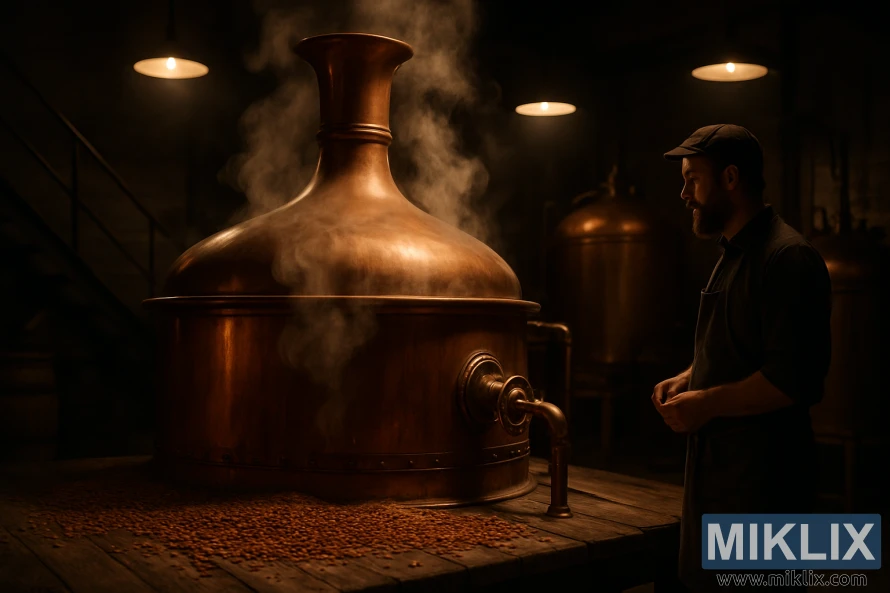
Key Takeaways
- Understand the flavor profile of pale chocolate malt and its uses in brewing.
- Learn techniques for incorporating pale chocolate malt into your beer recipes.
- Discover how to balance subtle chocolate and toast notes in your brews.
- Explore the history and development of pale chocolate malt.
- Get tips on brewing with pale chocolate malt for well-balanced beers.
Understanding Pale Chocolate Malt
Pale chocolate malt brings a mild chocolate and toasted taste to beer recipes. It's a brewing grain that adds a subtle chocolate flavor and aroma. This makes it perfect for brewers who want to add depth without overwhelming other tastes.
Unlike chocolate malt and roasted barley, pale chocolate malt has a milder flavor. Chocolate malt has a stronger, more pronounced chocolate taste. Pale chocolate malt, on the other hand, offers a gentler alternative. It's ideal for beers where a subtle chocolate note is needed.
- Pale chocolate malt adds a subtle chocolate flavor.
- It provides a toasted aroma that complements various beer styles.
- Its mild flavor profile makes it versatile for brewing different types of beers.
Using pale chocolate malt can elevate your beer's complexity. It's great for styles where a hint of chocolate is wanted but shouldn't overpower other flavors. Knowing how to use pale chocolate malt can lead to a more balanced and nuanced taste in your brews.
The History and Development of Pale Chocolate Malt
Pale chocolate malt's history is deeply rooted in the evolution of beer brewing. Its development is closely linked to advancements in malting technology and changing brewer preferences. This evolution has shaped the malt's role in brewing.
The origins of pale chocolate malt trace back to the early days of chocolate malt production. Initially, chocolate malts were darker, with a more robust flavor. As brewers sought more nuanced flavors, the need for a paler version grew.
To develop pale chocolate malt, the malting process was adjusted. This aimed to achieve a lighter color while keeping the chocolate flavor. This was done by carefully controlling roasting times and temperatures.
Now, pale chocolate malt is a staple in many breweries. It adds depth and complexity to various beer styles. Its adoption has been driven by brewers' desire to innovate and differentiate their products.
Today, pale chocolate malt continues to evolve. Different manufacturers offer their own versions. This diversity enriches the brewing landscape, providing brewers with a wider range of flavors.
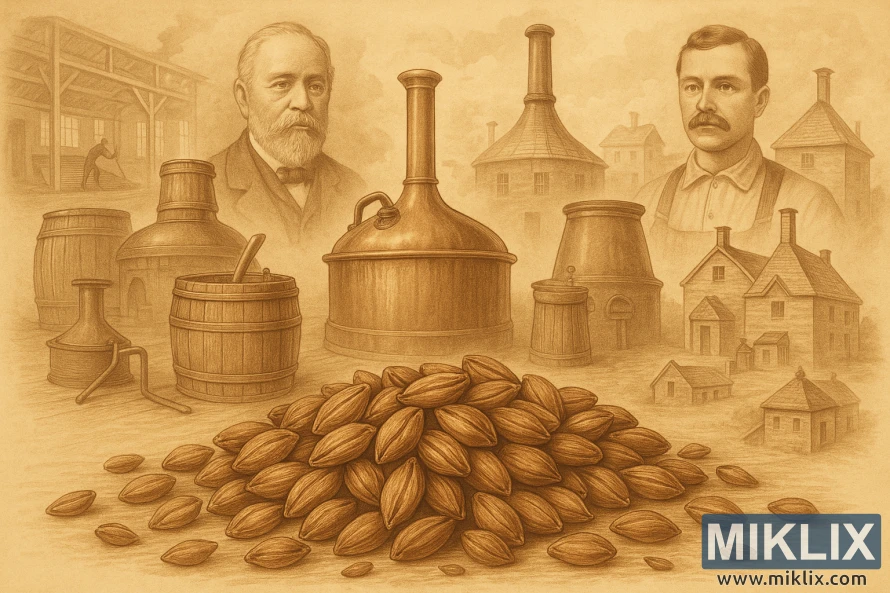
Flavor Profile and Characteristics
The flavor of pale chocolate malt is rich with notes of toast, caramel, and a hint of chocolate. It adds depth and complexity to beer without dominating it with a strong chocolate taste.
Pale chocolate malt brings a rich yet subtle flavor to beer. It offers a balance of sweetness, a touch of bitterness, and nuanced acidity. These elements enhance the drinking experience.
The key characteristics of pale chocolate malt are:
- A subtle chocolate flavor and aroma
- Notes of toast and caramel
- A balanced sweetness and bitterness
- A nuanced acidity that complements other ingredients
When brewing, pale chocolate malt creates complex and balanced flavors. It's perfect for beer styles where a subtle chocolate note is wanted. The malting process, with careful temperature and moisture control, shapes its flavor profile.
By adding pale chocolate malt to their recipes, brewers can craft sophisticated and nuanced beers. This enhances the overall quality of the brew.
Manufacturing Process of Pale Chocolate Malt
To craft pale chocolate malt, brewers must meticulously follow a malting and roasting protocol. This meticulous process is essential for achieving the distinct flavor and aroma of pale chocolate malt.
The journey starts with malting, where barley grains are immersed in water. This activates enzymes that convert starches into fermentable sugars. The grains then germinate, or sprout, further developing these enzymes.
Following germination, the grains are dried in a kiln or with hot air. This step is vital as it halts germination. It also preserves the enzymes and the delicate flavor compounds developed during malting.
The subsequent step is roasting, which amplifies the malt's flavor and aroma. For pale chocolate malt, roasting occurs at a lower temperature than darker malts. This approach ensures its characteristic mild chocolate and toasted notes.
The roasting process involves several critical factors. Temperature and duration are carefully managed to achieve the desired flavor profile. This results in a malt that adds a rich, yet subtle, chocolate flavor to beers without dominating them.
- Malting: Soaking, germination, and drying of barley grains.
- Roasting: Enhancing flavor and aroma at controlled temperatures.
- Quality Control: Ensuring the malt meets the desired flavor and aroma standards.
Understanding the manufacturing process of pale chocolate malt reveals the craftsmanship behind it. It shows how this specialty malt can elevate a brewer's beers.
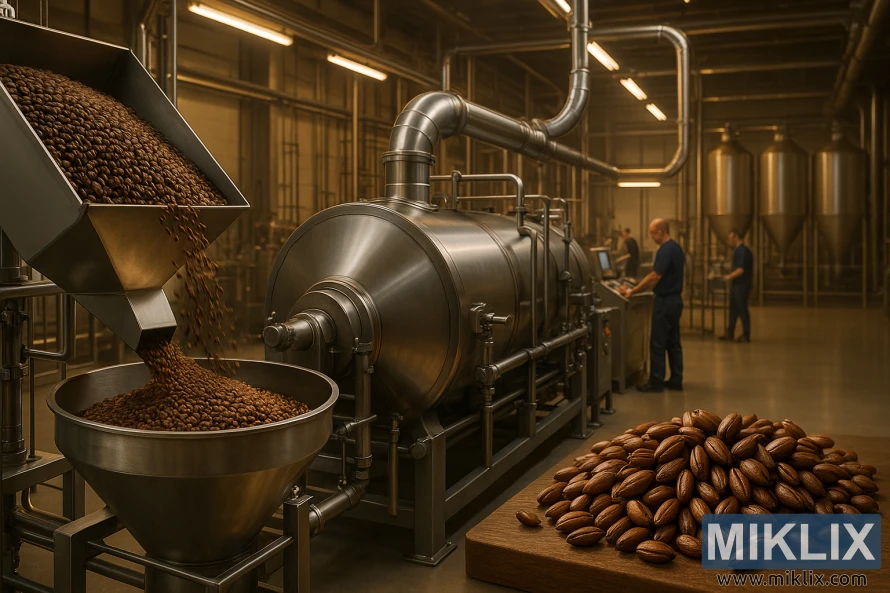
Comparing Different Brands of Pale Chocolate Malt
Different brands of pale chocolate malt offer a range of flavors and qualities. Brewers must compare and choose wisely. The flavor profile of pale chocolate malt can vary significantly between brands, impacting the overall character of the beer.
When comparing brands, several factors come into play. These include the malt's origin, production process, and quality control measures. For instance, some brands may produce pale chocolate malt with a more pronounced chocolate flavor. Others may offer a milder taste.
Here are some key considerations when evaluating different brands:
- Flavor profile: Look for descriptions or reviews that detail the malt's flavor characteristics.
- Quality: Check if the brand adheres to high-quality production standards.
- Usage in brewing: Consider how the malt is typically used in recipes and whether it's suitable for your brewing needs.
- Brand A: Known for its rich, chocolatey flavor and consistent quality.
- Brand B: Offers a milder flavor profile, suitable for brewers looking for a subtle chocolate taste.
- Brand C: Provides a high-quality pale chocolate malt with a balanced flavor profile.
By comparing these brands and considering their characteristics, brewers can make informed decisions. This comparison can help brewers achieve the desired flavor profile and quality in their beers.
Best Beer Styles for Pale Chocolate Malt
Pale chocolate malt is a versatile ingredient, suitable for a range of beer styles. It adds mild chocolate and toasted flavors, making it perfect for many brews.
Porters and stouts are among the most popular styles that benefit from pale chocolate malt. It enhances their deep, rich flavor profiles, complementing their roasted characteristics. Brown ales also gain from its nutty and slightly sweet notes.
Brewers can adjust the amount of pale chocolate malt to achieve the desired flavor. A higher amount intensifies the chocolate taste, while a smaller amount adds subtle complexity.
For those new to pale chocolate malt, starting with a small batch is recommended. This allows for experimentation and adjustments based on the malt's characteristics and the beer style.
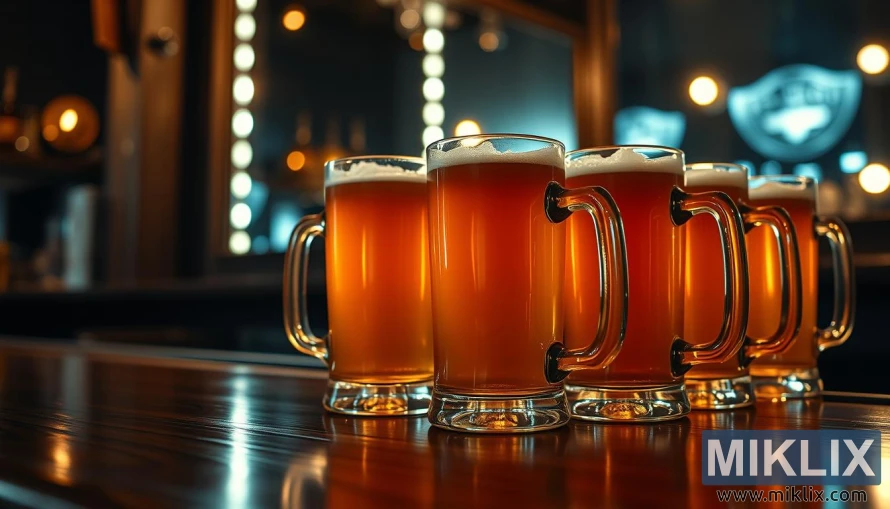
Recipe Development with Pale Chocolate Malt
Creating recipes with pale chocolate malt demands a thorough grasp of its taste and properties. This malt imparts a soft chocolate and toasted taste to beer, enriching a range of beer styles.
It's essential to balance the flavor of pale chocolate malt with other ingredients. This means considering how the malt affects the beer's overall taste and adjusting other components as needed.
To achieve complex and balanced flavors, brewers should follow these tips:
- Determine the role of pale chocolate malt in your beer. Will it be a main flavor or a subtle background note?
- Experiment with different ratios of pale chocolate malt to other malts to find the perfect balance.
- Think about the type of hops and other ingredients that will enhance the flavors from the pale chocolate malt.
By understanding how pale chocolate malt interacts with other ingredients, brewers can create unique and tasty beers. Whether brewing a stout, porter, or another style, this malt can add depth and complexity to your creations.
Mashing Techniques and Considerations
Mashing with pale chocolate malt demands a thorough grasp of temperature, pH, and water chemistry. This step in brewing mixes milled grains with hot water. It extracts fermentable sugars, enzymes, and compounds that shape the beer's flavor, aroma, and body.
Working with pale chocolate malt necessitates optimal mashing conditions to reveal its unique traits. The mashing temperature is key, influencing enzyme activity that converts starches into fermentable sugars. A temperature between 152°F and 155°F (66°C to 68°C) is recommended for a balanced sugar mix.
The pH level during mashing also plays a significant role, affecting enzyme activity and the brewing process. The ideal pH range is between 5.2 and 5.4. This range optimizes enzyme activity and minimizes the extraction of unwanted compounds from grains.
Sparging, rinsing grains with hot water after mashing, is critical when brewing with pale chocolate malt. The sparge water should be around 168°F (76°C). This temperature effectively extracts sugars without pulling excessive tannins from the grains.
To optimize mashing and sparging conditions for pale chocolate malt, brewers should focus on several key factors:
- Temperature control during mashing and sparging
- pH management to ensure optimal enzyme activity
- Water chemistry adjustments as necessary to achieve the desired brewing water profile
- Monitoring of the grain-to-water ratio to avoid over or under extraction
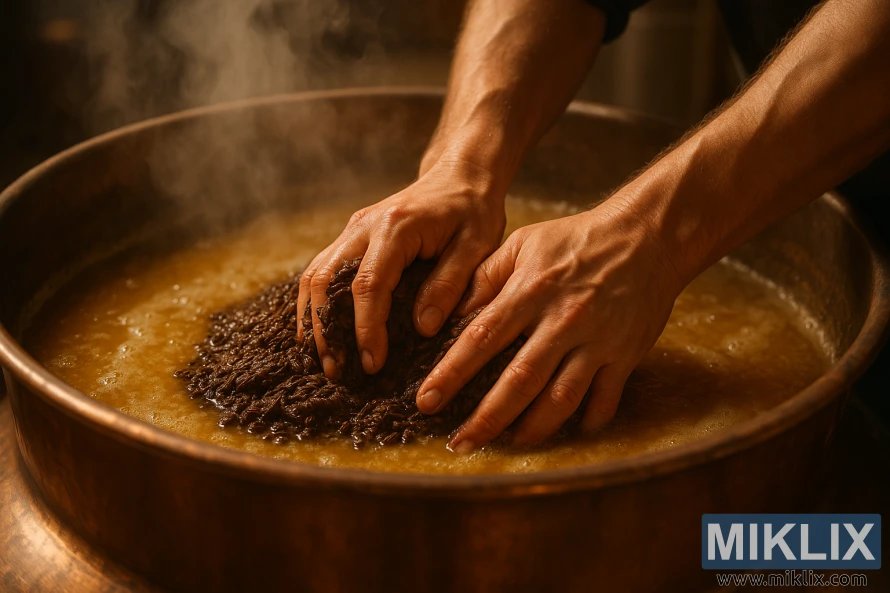
Common Brewing Mistakes to Avoid
When brewing with pale chocolate malt, it's vital to steer clear of common pitfalls. This malt can bring a rich, chocolatey taste to your beer. Yet, mishandling it can lead to unwanted flavors.
One major error is over- or under-extracting the malt. Over-extraction can make your beer taste bitter or astringent. On the other hand, under-extraction might result in a beer lacking the chocolatey taste you're aiming for. To sidestep this, it's essential to keep a close eye on your mashing temperatures and times.
Incorrect mashing and sparging methods are also common mistakes. Mashing at the wrong temperature can alter the sugar extraction and beer flavor. Sparging too much or too little can also affect the beer's taste and gravity. It's important to use the right techniques for your equipment and recipe.
Here are some tips for avoiding common brewing mistakes when using pale chocolate malt:
- Monitor your mash temperature closely to avoid over or under extraction.
- Use the correct sparging technique to prevent excessive tannin extraction.
- Be mindful of the amount of pale chocolate malt used, as too much can overpower the beer.
- Consider the type of pale chocolate malt and its characteristics when planning your brew.
By being aware of these common mistakes and taking steps to avoid them, brewers can ensure that their use of pale chocolate malt results in a high-quality beer with the desired flavor and aroma characteristics.
It's also important for brewers to consider the quality of their pale chocolate malt. Ensuring it is fresh and stored properly is key to unlocking its full flavor and aroma. Freshness and proper handling are essential for achieving the best results with this specialty malt.
Storage and Handling Guidelines
To keep pale chocolate malt in top condition, following proper storage and handling is key. The right storage conditions are vital for preserving its flavor and aroma. This specialty malt requires careful attention to maintain its quality.
For storing pale chocolate malt, a cool, dry spot away from sunlight and moisture is essential. The ideal temperature range is 50°F to 70°F (10°C to 21°C), with low humidity. This prevents staleness and off-flavors from developing.
When handling pale chocolate malt, it's important to be gentle to avoid damage or contamination. Always use clean, dry tools and equipment. This prevents moisture or foreign particles from getting into the malt.
- Store pale chocolate malt in airtight containers to maintain freshness.
- Keep the storage area free from strong-smelling foods, as malt can absorb odors easily.
- Check on stored malt regularly to ensure it remains fresh and free from pests.
By adhering to these guidelines, brewers can keep their pale chocolate malt in the best condition. This ensures it adds its unique flavor to their beer recipes.
Troubleshooting Your Pale Chocolate Malt Brew
Perfecting a brew with pale chocolate malt requires troubleshooting. Issues like off-flavors, poor head retention, and inconsistent fermentation can occur. Understanding how to tackle these problems can greatly enhance your beer's quality.
One frequent problem with pale chocolate malt is off-flavors. These can manifest as soapy, metallic, overly bitter, or astringent tastes. To prevent these, it's vital to store your malt correctly and use it before its expiration date.
Poor head retention is another challenge in brewing with pale chocolate malt. It can stem from various factors, including yeast type, fermentation temperature, or compounds affecting foam stability. Keeping your equipment clean and sanitized, and choosing the right yeast, can help solve this issue.
Inconsistent fermentation is another hurdle when using pale chocolate malt. Incorrect mash temperatures, inadequate yeast nutrients, or contamination can cause problems. By monitoring fermentation temperatures and ensuring yeast has the right nutrients, you can achieve consistent fermentation.
To effectively troubleshoot your pale chocolate malt brew, consider these steps:
- Review your recipe and brewing process for any issues.
- Check the quality and freshness of your pale chocolate malt.
- Ensure your equipment is clean and sanitized.
- Monitor your fermentation temperatures and yeast health.
By following these steps and being aware of brewing challenges with pale chocolate malt, you can enhance your beer's quality. This will help you achieve the desired flavor and aroma.
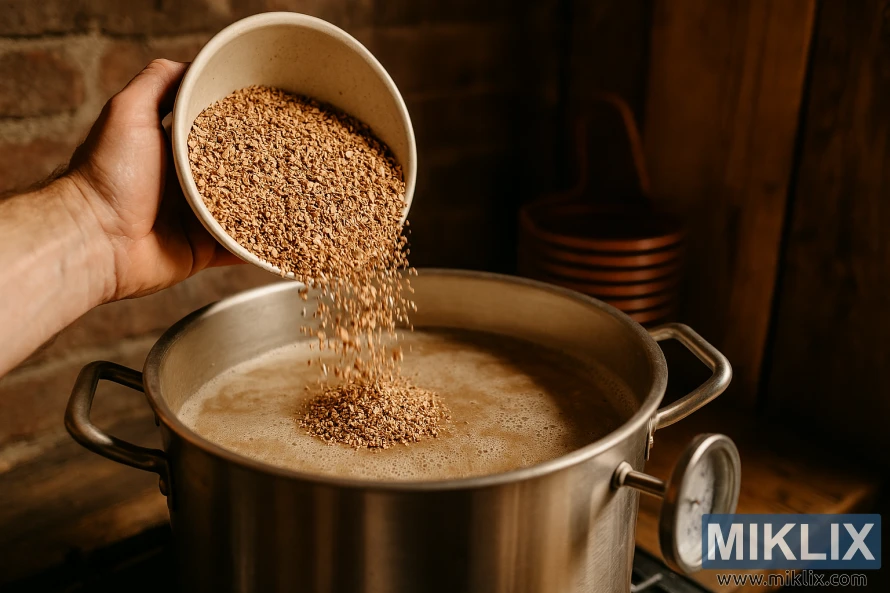
Food Pairing Suggestions for Beers with Pale Chocolate Malt
Pale chocolate malt beers are versatile and can complement a range of dishes, from desserts to savory meals.
When it comes to desserts, pale chocolate malt beers pair exceptionally well with chocolate-based treats. The malt's cocoa flavor enhances the richness of the chocolate, creating a delightful taste experience.
For cheese pairings, pale chocolate malt beers complement strong, pungent cheeses like blue cheese or aged cheddar. The beer's maltiness balances the bold flavors of the cheese, resulting in a harmonious combination.
In terms of savory dishes, pale chocolate malt beers can be paired with roasted meats, such as beef or lamb. The beer's complex flavor profile, with notes of toast and cocoa, complements the charred, savory flavors of the roasted meats.
- Pair pale chocolate malt beers with chocolate desserts for a rich, indulgent experience.
- Combine with strong cheeses, like blue cheese or aged cheddar, for a balanced flavor profile.
- Enjoy with roasted meats, such as beef or lamb, for a savory and satisfying meal.
By exploring different food pairing options, you can elevate your brewing experience and discover new favorite combinations.
Commercial Examples Using Pale Chocolate Malt
The versatility of pale chocolate malt is evident in its widespread adoption among commercial breweries. It's used to craft a wide range of beer styles. Its unique flavor profile, with milder chocolate and toasted notes, attracts brewers looking to add depth and complexity to their beers.
Several well-known breweries have successfully incorporated pale chocolate malt into their recipes. For instance, Sierra Nevada and Bell's Brewery have used it in their amber and brown ales. This enhances the maltiness and adds a subtle chocolate flavor. The result is a balanced beer with a rich, malty backbone and a hint of chocolate that complements the hoppy notes.
Some breweries have also experimented with pale chocolate malt in darker beer styles, such as porters and stouts. By combining it with other specialty malts, brewers can achieve a complex flavor profile. This includes notes of dark chocolate, coffee, and toasted malts. Examples include Firestone Walker and Deschutes Brewery, which have produced robust porters and stouts with layered flavors.
The use of pale chocolate malt is not limited to traditional beer styles. Some innovative breweries have incorporated it into IPAs and pale ales. This adds a unique twist to these hop-forward beers. The malt's subtle chocolate flavor can balance the bitterness of the hops, creating a more harmonious flavor experience.
For homebrewers and professional brewers alike, these commercial examples serve as inspiration. They show how to experiment with pale chocolate malt in various beer styles. By understanding how different breweries use this malt, brewers can gain insights into balancing flavors and creating unique beers that showcase the characteristics of pale chocolate malt.
Conclusion
Pale chocolate malt brings depth and complexity to various beer styles. Its flavor profile, with milder chocolate, toast, and cocoa notes, is highly appealing. This makes it a great addition to many brews.
We've delved into its history, manufacturing, and best uses in brewing. Understanding its characteristics and applications opens up new possibilities for complex and delicious beers. Brewers can now explore new flavors and aromas.
Using pale chocolate malt can be a rewarding journey. It allows brewers to innovate beyond traditional styles. Whether you're experienced or new, adding it to your recipes can lead to exciting new tastes.
As you continue to brew with pale chocolate malt, remember to store and handle it correctly. This ensures the best results. With time and effort, you'll master this ingredient, creating beers that impress even the most critical palates.
Further Reading
If you enjoyed this post, you may also like these suggestions:
